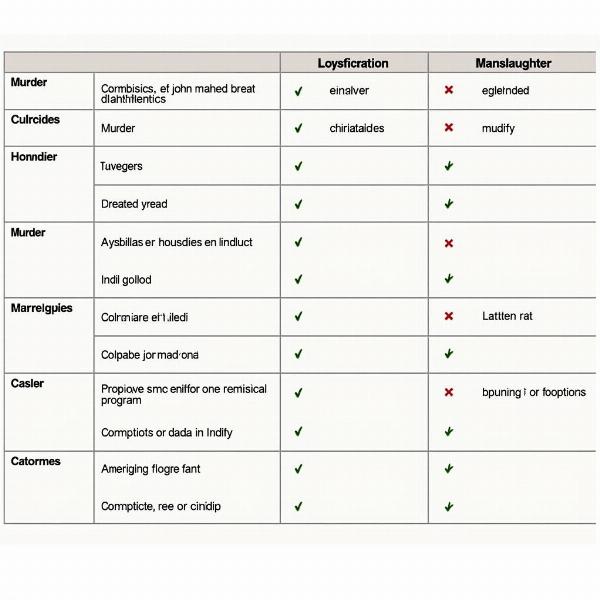Understanding the meaning of homicide is crucial, especially in a legal context. “Homicide” itself isn’t a Hindi word; it’s derived from English. So, when looking for its Hindi equivalent, we’re essentially searching for the best way to convey the concept of the unlawful killing of one human being by another. This brings us to various terms depending on the specific nature of the act, including intent and circumstances. This article will explore the nuances of “meaning of homicide in hindi” and the various Hindi terms used to describe this act.
Understanding “Homicide” in the Indian Legal Context
While “homicide” finds no direct equivalent in traditional Hindi, Indian law, heavily influenced by British jurisprudence, often uses anglicized versions of Hindi terms related to killing. This can sometimes create confusion. For example, “qatl” (क़त्ल) is often used in legal discourse and broadly translates to killing. However, it doesn’t always carry the same legal weight as “homicide” in English. To properly translate “homicide,” we need to consider the specific context and the corresponding Indian Penal Code (IPC) sections.
Exploring Hindi Terms for Unlawful Killing
Several Hindi words describe different forms of unlawful killing. These distinctions are crucial for legal accuracy and understanding the “meaning of homicide in hindi” within specific contexts.
- हत्या (Hatya): This is perhaps the closest equivalent to “murder” in English, implying intentional killing. It refers to the unlawful taking of a human life with malice aforethought.
- मानव वध (Maanav Vadh): This term literally translates to “human slaughter” and is often used in more formal or literary contexts. It carries a sense of brutality and encompasses a broader range of unlawful killings.
- खून (Khoon): This term refers to “blood” or “bloodshed” and is often used colloquially to refer to murder or killing. However, it lacks the legal precision of terms like “hatya.”
- मार डालना (Maar Daalna): This phrase, meaning “to kill,” is commonly used in everyday language but is less formal and doesn’t specify the legality or intent behind the killing.
What Does a Person Searching for “Meaning of Homicide in Hindi” Actually Want to Know?
Someone searching for “meaning of homicide in hindi” likely needs clarification on the legal and cultural implications of this term within the Indian context. They might be:
- Legal professionals: Looking for accurate translations for legal documents or courtroom proceedings.
- Students: Studying law or criminology and seeking a deeper understanding of the relevant terminology.
- General public: Trying to understand news reports, legal documents, or literature involving homicide.
The Importance of Context in Translation
Understanding the context is paramount when translating “homicide” into Hindi. Different situations require different terms. For instance, “culpable homicide” (गैर इरादतन हत्या – gair iradatan hatya) is distinct from “murder” (हत्या – hatya) under Indian law. manslaughter meaning in hindi similarly requires a nuanced translation.
What is the Difference Between Murder and Homicide?
While both terms relate to the killing of a human being, “murder” implies premeditation and malice, while “homicide” can encompass a broader range of unlawful killings, including manslaughter and other forms. This distinction is reflected in the Hindi terminology and legal interpretations within the Indian Penal Code.
 Murder vs. Homicide in Indian Law
Murder vs. Homicide in Indian Law
Conclusion
The “meaning of homicide in hindi” isn’t straightforward. It requires considering the specific context, legal implications, and cultural nuances. Using accurate terminology is crucial for clear communication and understanding within the Indian legal and social landscape. The various Hindi terms available allow for a precise description of the different forms of unlawful killing, ensuring legal accuracy and a deeper understanding of the concept. natural death meaning in hindi offers a contrast to these terms, highlighting the importance of precise language in legal and medical contexts.
FAQ
- What is the most common Hindi word for “homicide”? While there’s no single perfect equivalent, “hatya” (हत्या) is often used for intentional killing, similar to “murder.”
- Is “khoon” (खून) an accurate translation of “homicide”? “Khoon” refers to blood or bloodshed and is used colloquially for killing, but it lacks legal precision.
- How does Indian law define homicide? The Indian Penal Code (IPC) defines various forms of unlawful killing, including murder, culpable homicide, and manslaughter, each with distinct legal implications.
- Why is context important when translating “homicide”? Context helps determine the appropriate Hindi term based on the specific nature of the killing, including intent and circumstances.
- Where can I find more information on Indian legal terminology in Hindi? Legal dictionaries and resources on Indian law provide detailed explanations of relevant terms and their applications.
- What is the difference between “hatya” and “maanav vadh”? “Hatya” usually implies intentional killing, while “maanav vadh” is a more formal term often used in literary contexts and carries a broader meaning.
- How can I ensure accurate translation of “homicide” in legal documents? Consulting with legal professionals specializing in Hindi and English is crucial for accurate legal translation.
Meaning-Hindi.in is your trusted partner for professional Hindi translation services. We offer expert translation for legal, business, technical, and academic documents. Our team of experienced linguists ensures accuracy, cultural sensitivity, and timely delivery. Whether you need to translate legal documents related to homicide or other complex texts, Meaning-Hindi.in provides high-quality translations tailored to your specific needs. Contact us today for a free quote at [email protected] or call us at +91 11-4502-7584.